The Eurasian Collared-Dove is a common, medium-sized dove species very much adapted to living with people.
This pale brown and gray dove with a black line on the back of the neck, dark primaries, and black and white in the tail thrives in agricultural and urban areas with scattered trees.
Where present, this dove species is easy to see perching on roadside wires, visiting feeders, and feeding on open ground.
On this page
Identification
The Eurasian Collared-Dove is a medium-sized dove that is mostly pale gray and pale brown, and with a black line on the back of the neck. Their bills are black, eyes reddish-brown, and their wings have darker flight feathers. Eurasian Collared-Doves have a contrasting gray area in the shoulder and secondary feathers that are more visible in flight.
The longish, pale tail has white outer tail feathers and the underside has a black base. Male Eurasian Collared Doves are slightly larger and heavier than females. They also tend to have slightly more pinkish plumage, especially on the underparts.
For the first few months, juvenile birds resemble adults but are smaller, have more of a pale brown coloration, and buff scaling on the upper parts.
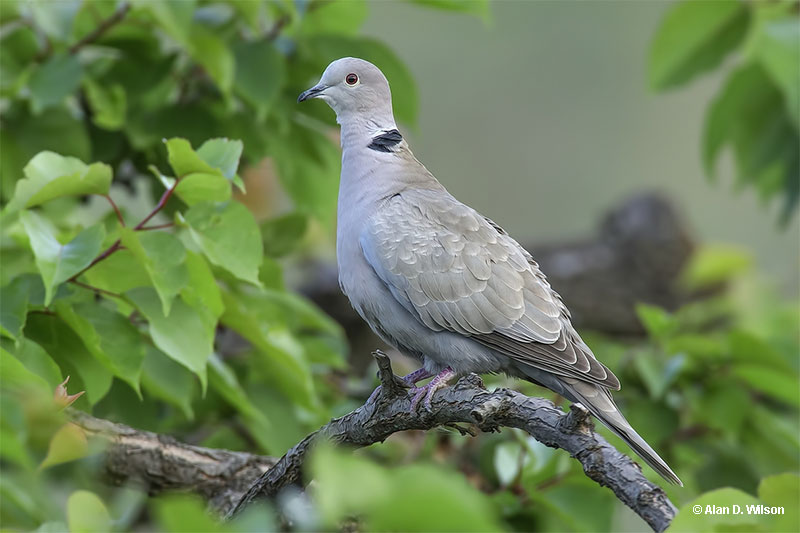
© Alan D. Wilson
The Eurasian Collared-Dove has a quick, direct flight. When flying, the dark flight feathers contrast with the pale gray on the secondaries and shoulder of the wing, and the white outer tail feathers are more visible, especially when the bird spreads its tail.
Both male and female birds give a three-noted “hoo HOO hoo” vocalization. But still, males are louder and deeper in frequency. It calls most often in the morning, even before dawn, from a tall tree or rooftop.
Food
Eurasian Collared-Doves feed on a variety of seeds and cereal grains but they seem to prefer larger grains and seeds such as sunflower and corn. They also commonly eat millet, buckwheat, oats, rye, and milo. Eurasian Collared-Doves are known to take elderberries and other types of berries from bushes and trees.
This species is very adaptable and has also been seen feeding on green algae at the edge of the water, crackers, crushed pecans and peanuts, and other food items that have fallen off trucks or from storage containers in warehouses.
This dove mostly forages on seeds, grain, and other items by picking them from the open ground in fields and feeding on spilled grain at farms, near silos, in parking lots, and other open situations.
They also regularly visit bird feeders to feed on commercial bird seeds. They can be seen taking berries by picking them from bushes and trees while perched or in brief hovering flight.
This species can feed alone but often occurs in flocks, groups of hundreds of birds in some places. It can also be seen feeding with flocks of Mourning Doves and blackbirds.
Nesting and Eggs
The Eurasian Collared-Dove can nest any time of the year but usually nests during the spring and summer months. The male shows the female several potential nest sites. When she chooses one, she constructs the nest with twigs, grasses, and other bits of vegetation.
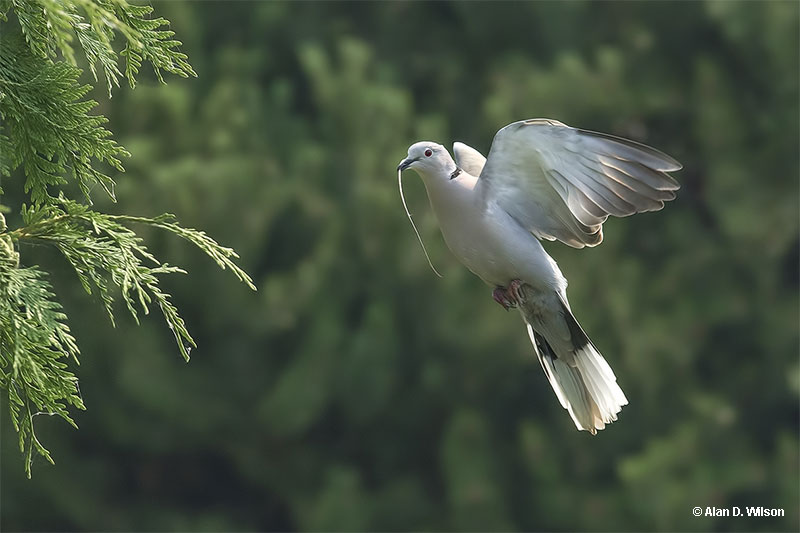
© Alan D. Wilson
The male doesn’t help build the nest, but he does bring nesting material to the female and pushes some twigs into the nest. The nest is an obvious and unkempt, shallow platform placed in a tree or on a building or other structure and can be anywhere from 6 to 60 feet above the ground. However, most are around ten to twelve feet high.
The average diameter of the nest of this dove species is 10.2 inches, and the height is around 8.2 inches.
Two smooth, white eggs are laid and then incubated by both parent birds for fourteen to nineteen days. Each egg weighs from 7 to 10 grams. After hatching, nestlings are fed regurgitated food by both parents. At first, the female gives them “crop milk”, a cottage cheese like substance.
After several days, the male feeds them regurgitated seeds and other food items. The young birds leave the nest 18 to 20 days after hatching and can still be given food by the male for a week after they fledge.
Current Situation
The Eurasian Collared-Dove lives in farmlands and any semi-open area with trees, including parks and other urban situations.
It occurs in India and Central Asia, China, Europe, the Middle East, North Africa, and in much of western and southern Canada, southern Alaska, and in most of the USA. This species has also spread to Mexico and Central America and is well established in the islands of the Caribbean Sea.
This species is common to abundant in many areas, and easy to see, especially around farms, and in Europe. Populations in North America spread and became established after a number of birds escaped captivity in the Bahamas in the 1970s.
At least 8 million Eurasian Collared-Doves are believed to live in the USA and Canada and it is considered an invasive species. For this reason, it is not given any degree of protection from hunting but even with some being shot each year, the species is probably still increasing, at least in urban areas.
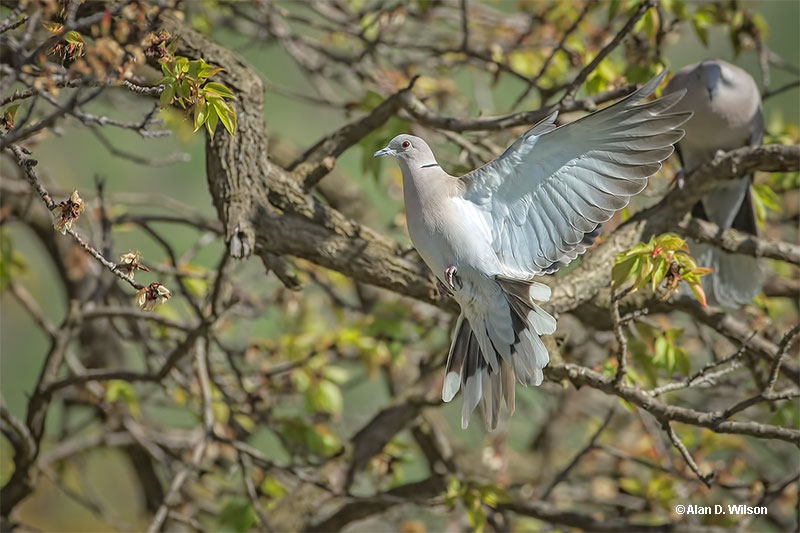
© Alan D. Wilson
Facts
- The Eurasian Collared-Dove is one of a few species that thrives in the presence of people. As long as trees or some structures for nesting are available, it can survive by feeding on seed, grain, and other food that it finds in parks, gardens, and open fields.
- The scientific name for this species, “Streptopelia decaocto” stems from the Greek language and a Greek myth about the bird. “Streptos” means “collared,” “peleia” means “dove”, and “deaocto” means “eighteen.” According to the myth, a maid who worked very hard but was only paid 18 coins per year, prayed that all of the world would know how badly she had been treated. In answer to her prayers, Zeus turned her into the Eurasian Collared-Dove, a bird that constantly says “deca-octo”.
- The Eurasian Collared-Dove didn’t spread into Western Europe until the 20th century. Its ability to colonize Europe may be related to a genetic adaptation for dispersal where birds become established some distance from their point of release. Its success might also be related to the availability of food and other factors.
- The Eurasian Collared-Dove first reached the USA in Florida after captive birds had escaped or were released in the Bahamas and the island of Guadalupe.
- In common with rather few other bird species, Eurasian Collared-Doves can drink by sucking the water up through their bill as if it were a straw.
Similar Species
In North America, the Eurasian Collared-Dove can usually be recognized by the black mark on its nape. However, there are a few other species it could be potentially confused with.
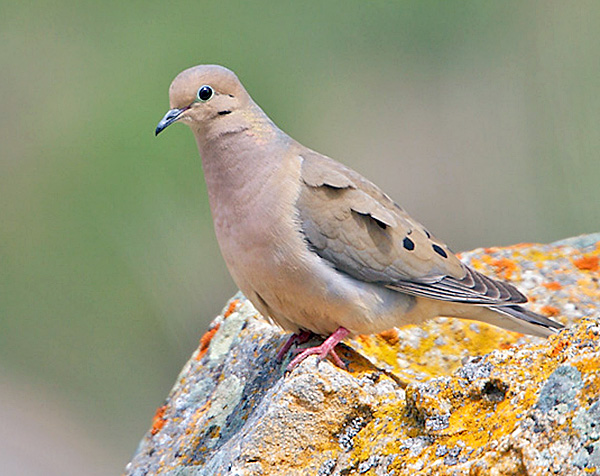
Mourning Dove. Photograph © Greg Lavaty.
The Mourning Dove also lives in urban zones, parks, and on farms; the same places frequented by the Eurasian Collared-Dove. However, the Mourning Dove has a pointed tail, and has dark spots in the wings instead of on the nape.
See more: Types of doves in the U.S.
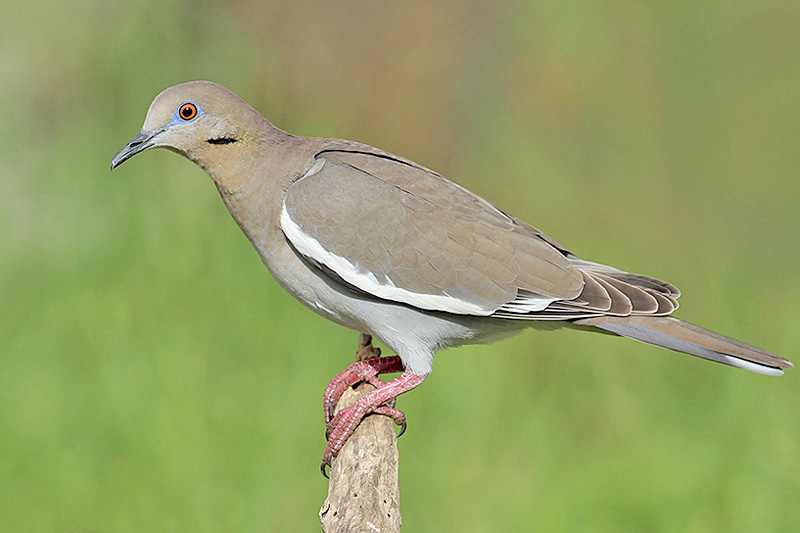
White-winged Dove
The White-winged Dove is pretty similar in size and shape and can also occur in similar habitats but lacks black on the nape, has a black spot on the side of the neck just below its face, and has a large white stripe in the wing.
Frequently Asked Questions
What is the difference between a Eurasian Collared-Dove and a Mourning Dove?
The Eurasian Collared-Dove has a black mark on the nape, and more white in a squared, rather than pointed, tail.
Is the Eurasian Collared-Dove a pigeon?
The Eurasian Collared-Dove is in the same family as Rock Pigeons and other pigeon species.
Are collared doves friendly?
Yes, the Eurasian Collared-Dove could be considered “friendly” because this species is a lot more tame than other bird species, and comes to backyard feeders.
Why is the Eurasian Collared-Dove a problem?
The Eurasian Collared-Dove is an invasive species. It may compete with native species, and eat seed and cereal crops.

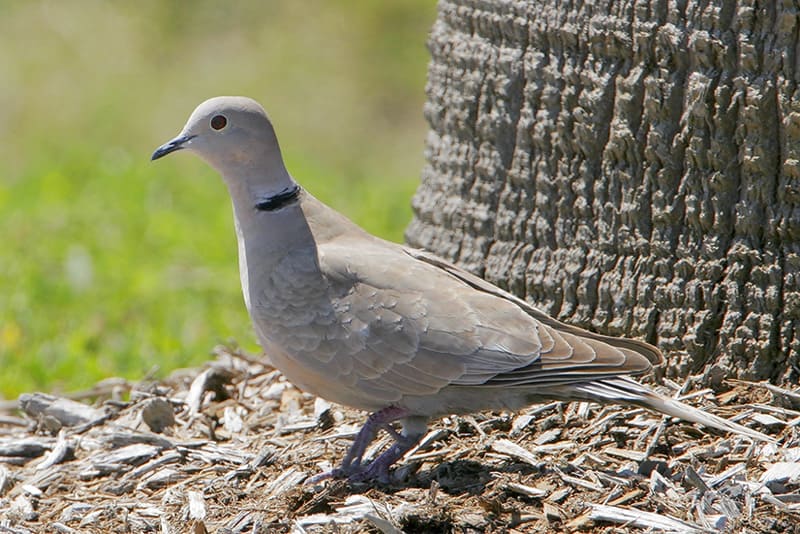

Jan
Friday 8th of September 2023
Good information. I have a wild pet Eurasian Collared dove. She showed up in our backyard two years ago. The dove seemed a little distraught. She flew up on my head. She was probably someone's pet. Since then, she has come to our house about 3X a day, sometimes bringing her mate. She is very comfortable inside or outside. Thanks for the post.